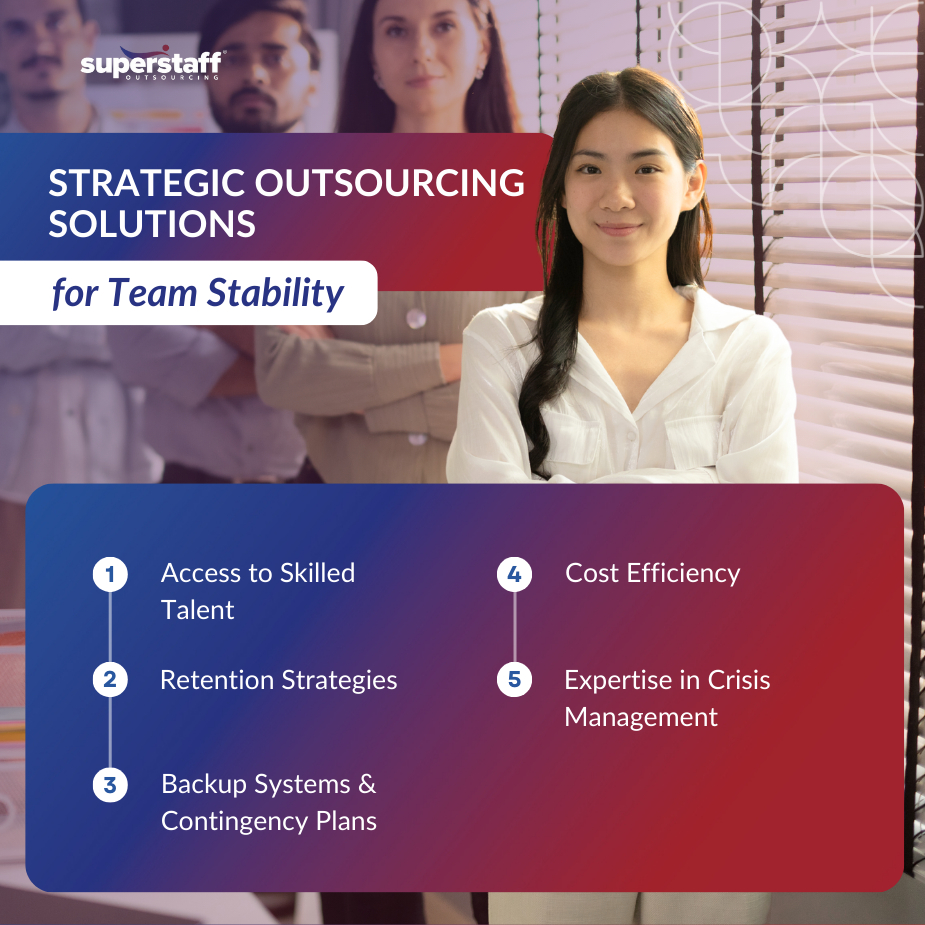
High employee turnover and underperformance can disrupt your business and drain valuable resources. The constant need to hire, train, and manage performance can make it feel like the pressure never ends. With teams constantly changing, it becomes difficult to maintain productivity and keep morale high. But there is a solution that can help: strategic outsourcing solutions.
Offshore staffing support offers a practical way to address turnover and performance issues by providing businesses with skilled teams to step in when needed. Whether you’re dealing with seasonal fluctuations, unexpected employee departures, or a high turnover rate, outsourcing allows you to maintain smooth operations without the endless cycle of recruiting and training.
If employee turnover slows your business down, it’s time to take a different approach. Explore how outsourcing can help your business stay strong, no matter what challenges come your way.
The Rising Cost of Attrition and Underperformance
Employee turnover can cost your business more than you might expect. It doesn’t just involve the time and money spent on hiring and training—it also takes a toll on productivity, team morale, and overall stability.
Replacing a single employee can cost anywhere from half to twice their yearly salary, depending on their role. For mid-level positions, the cost often ranges between 125% to 150% of their annual pay. In more specialized or senior roles, that number can go even higher—up to 400%.
Here’s where those costs come from:
- Recruitment and training expenses: Hiring and training new employees takes time and resources away from daily operations. During that ramp-up period, productivity often dips.
- Loss of knowledge and experience: When seasoned employees leave, they take hard-earned knowledge about processes, relationships, and company culture with them.
- Lower morale and motivation: High turnover can wear down the rest of your team. As workloads grow and uncertainty builds, job satisfaction may fall, leading to more resignations.
Even with strong hiring strategies, turnover continues to disrupt business. That’s why many companies are looking for smarter ways to stay steady, and outsourcing is one of them.
How Outsourcing Helps Stabilize Teams During High Turnover
When turnover is high, maintaining smooth operations becomes challenging. Outsourcing provides an effective way to fill gaps quickly and keep things running without interruption. Here’s how outsourcing helps:
- Access to skilled talent: With outsourcing, you can immediately tap into a pool of skilled professionals who can immediately jump in and contribute. This eliminates the waiting period required for new hires to get up to speed.
- Retention strategies: Outsourcing companies often have strategy to keep their teams satisfied. Through ongoing training, career development, and competitive pay, they help reduce turnover on their side, ensuring a stable support system for your business.
- Backup systems and contingency plans: Outsourcing companies are built for continuity. If a team member leaves unexpectedly, they have the structure to quickly bring in a replacement without slowing down your operations.
This readiness reflects a key principle highlighted by Forbes: businesses must plan for setbacks, the challenges of rapid growth, and unexpected changes. A backup plan helps your business stay on track when something unexpected happens. When you outsource, that plan is already built in.
By relying on outsourced teams, your business stays on track despite high turnover rates.

Improving Accountability and Performance Through Outsourcing
One of the main concerns when dealing with high turnover is whether the work will continue to be done well and on time. Outsourcing addresses this challenge with strategic outsourcing solutions that provide clear structures to ensure performance stays high.
Here’s how outsourcing can improve accountability:
1. Regular performance evaluations
Outsourcing companies assess team performance regularly to ensure that everyone meets or exceeds expectations. If there are any underperforming employees, they are either coached or replaced quickly.
2. Ongoing training and coaching
Continuous training and development help outsourced teams stay sharp and motivated, resulting in higher-quality work and greater job satisfaction.
3. Workflow optimization
Many outsourcing companies specialize in streamlining processes, improving efficiency, and reducing errors. This keeps your operations smooth and productive, even when internal resources are stretched thin.
By focusing on outsourcing for team performance, businesses can maintain high standards and consistent output, even during periods of high turnover.
Strategies Outsourcing Companies Use to Reduce Attrition
Outsourcing companies implement effective strategies that demonstrate how outsourcing can reduce employee attrition and boost performance, including competitive compensation and continuous career development. These include:
1. Ongoing training and development
Outsourcing firms invest in continuous training programs to keep employees’ skills sharp and provide opportunities for career growth, helping them feel valued and engaged.
2. Well-being initiatives
Many outsourcing companies offer wellness programs, mental health support, and flexible work arrangements to ensure employees maintain a healthy work-life balance and avoid burnout.
3. Competitive compensation
By offering competitive pay, bonuses, and other incentives, outsourcing companies ensure they attract and retain top talent, preventing turnover due to dissatisfaction with compensation.
4. Clear career paths
Providing structured career progression opportunities within the company motivates employees to stay long-term, as they can see a clear path for growth and advancement.
These strategies help outsourcing firms stabilize their teams, allowing businesses to rely on consistent, high-quality service.
In-House vs. Outsourced Teams: Which Model Is More Effective?
If you’re wondering whether in-house teams or outsourced teams are more effective, here’s a side-by-side comparison:
- Onboarding and training – In-house teams often take longer to onboard, mainly when turnover occurs. Training can take several months, and productivity may dip during that time. Outsourced teams, however, are ready to go with minimal training, making them more efficient right from the start.
- Consistency and adaptability – While in-house teams can struggle with consistency during periods of high turnover, offshore staffing support ensures that businesses can scale rapidly and maintain consistent performance even during challenging times.
- Scalability – Outsourcing allows businesses to scale up quickly, whether you need to fill a single position or an entire department. In-house teams can take longer to scale, especially if talent is hard to find.
Outsourcing provides the flexibility and stability that in-house teams may struggle to offer, especially when turnover is high.
Stop the Cycle of Turnover — Strengthen Your Team with Outsourcing
High employee attrition and underperformance can stall growth and disrupt operations. With the right outsourcing partner, you can stabilize your workforce, reduce hiring costs, and maintain consistent performance.
SuperStaff supports this with solutions like Recruitment Process Outsourcing (RPO), burnout prevention strategies, and flexible staffing models — all designed to help businesses stay resilient.
Partner with SuperStaff and take a proactive step toward reducing turnover and improving performance with our strategic outsourcing solutions.






